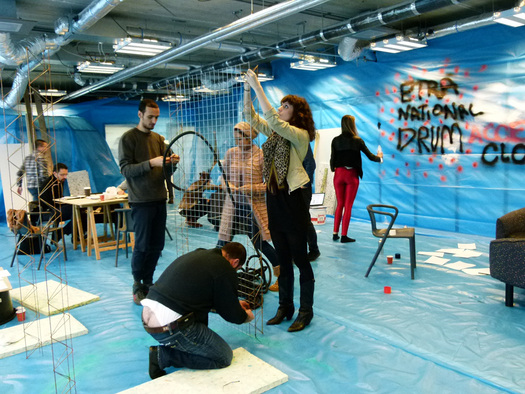
April 17, 2012
Extra National Journey

Extra National workshop in progress
What happens when a Russian-born American professor takes a group of his Arab students to a workshop in Amsterdam to work with a designer who has a Canadian passport but lives in Berlin?
National identities clash with globalization: this is a reality of today’s world, and reverberations of this conflict are evident in contemporary design discourse. On one hand, the national is still much valued as a precious cultural resource. On this topic, in a recent issue of Domus, MoMA Design Curator Paola Antonelli recently wrote about “digging deep into local culture in order to achieve the universal sublime”. Notes Antonelli: “Local traditions have in recent decades proved to be the most meaningful way to move beyond modernism without giving up the great qualities of modern design”.
On the other hand, there’s no denying that our global village is getting more standardized. Developments with the internet have both facilitated and enabled a globally homogeneous way of banking, manufacturing, commerce, branding and pop-culture. The world of young people, in particular, is a unified one in which music, fashion, games and social media have created a global infrastructure that stretches far beyond any national borders. These people live in the era of Google Earth, which allows them to zoom in on any country or city without leaving their computers. One of the missions of design education today is to address this complex condition, and to uncover strategies for its creative exploitation.
Nicolas Bouriaud’s The Radicant (Lucas and Stenberg, New York, 2009) lays out a promising theoretical framework for artists’ and designers’ work in the first decades of the new century. The notion of radicant comes from botany: it is “a term designating an organism that grows its roots and adds new ones as it advances”. According to Bouriaud: “To be radicant means setting one’s roots in motion, staging them in heterogeneous contexts and formats … translating ideas, transcoding images, transplanting behaviors, exchanging rather than imposing.” Instead of postmodern games with history and heritage typically expressed through use of signs and décor, this new work is characterized by formlessness and temporality: it favors process over object, the journey over the destination.
The ideas in this prescient book have been recently put into action through a joint workshop set up between VCUQatar in Doha and the Sandberg Institute in Amsterdam: the idea is based on the notion of Extra National Style, a theme proposed by Jerszy Seymour (Director of the Dirty Art Department at Sandberg). The idea of Extra National defies easy definition: it is not a fusion of cultures (such as might be favored by Postmodernism) nor does it require abandoning all cultural references in favor of a single unified language, as was the case with International Style ― the fruits of which are still in evidence in many airports and public spaces still today.
If anything, the notion of Extra National recalls a much older concept, that of cosmopolitanism: the belief that all humans belong to one single global community based on a shared morality. When the ancient Greek philosopher Diogenes was asked where he was from, he famously replied that he was a citizen of the world, or a cosmopolite. In contemporary thinking, cosmopolitanism questions the inevitability of nation-states and advocates the world political system that promotes personal freedom and individual opportunity. An essential feature of cosmopolitanism is respect for otherness, which implies an acknowledgement of religious and cultural differences. “I hate border controls, but I love different food and cheeses,” says Jerszy Seymour.
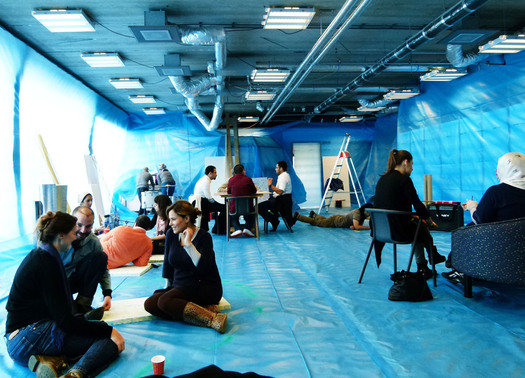
Students in the blue space on their first day
Working in the Extra National style does not mean leaving behind the idea of national belonging, but rather suggests making a selective inventory of what is worth keeping and asking why? As students tried to grasp and define the idea, words like “fluid”, “intangible” and “unreachable” dominated the discussion, until the group started to focus on the moment ― the here-and-now. Indeed, the essence of this project could well be defined by its unique and multinational list of participants, assembled somewhat miraculously in one space. The large studio — sheathed entirely in seamless blue plastic that was itself devoid of any specific cultural references — had become the stage of Extra National action.
In this new environment, students’ national backgrounds appeared to have been suspended. Two Israeli students worked and made friends with kids from Lebanon and Qatar: clearly, this is something that could never happen in the course of their regular day-to-day lives. Qatari girls temporarily shed their black abayas, while Dutch girls joined in chanting traditional Arab songs. Students were invited to transform the blue space as needed in the process of their daily work.
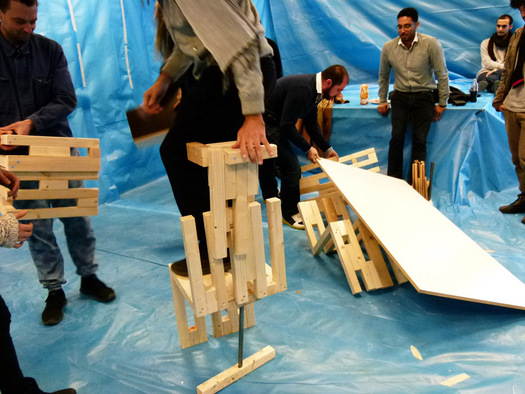
Intangible furniture being tested by the workshop participants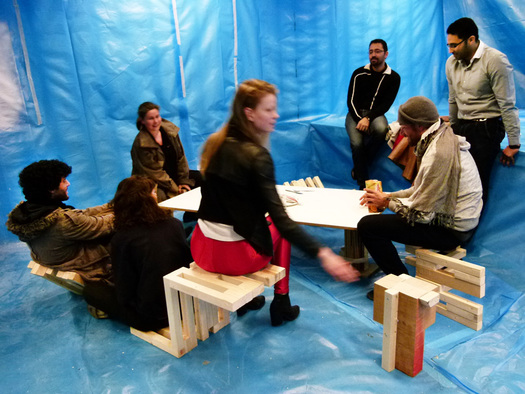
Intangible furniture being tested by the workshop participants
Initial ideas focused on students’ basic needs as human beings: establishing a ritual of one minute of breathing, or sending containers of air from country to country in exchange. From the study of air the attention turned to music ― a truly Extra National phenomenon, especially for young people. A group of students proposed an interactive musical map of the world, an invisible auditory presence open for browsing and adding one’s own voice. Another team worked on the needs of their working space, offering a collection of Intangible Furniture: they were multifunctional toy-like fragments, capable of personalized configurations. The entire class happily joined in exploration of the system’s combinatory possibilities.
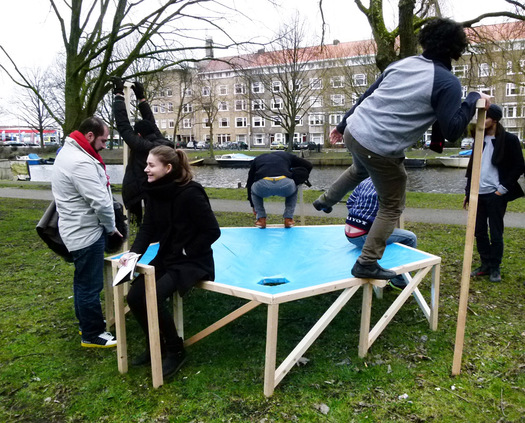
A group of students demonstrating their design for an Extra National toilet
Intrigued by the observations of the Slovenian philosopher Slavoj Zizek (who famously analyzed the difference between German, American, and French toilet bowls as the key to the three nations’ ideological differences), the next group examined a quintessentially human need, setting out to create a prototype of an Extra National toilet. The project ended up as an outhouse and was constructed outside of the school building. Its pentagon shape corresponded to five dissimilar ways of use from five different continents, all unified with one common drain hole.
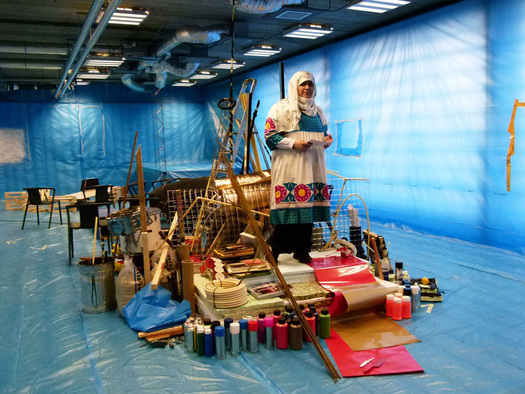
The Cloud, which incorporated components and unused materials from all other students’ projects
Collective projects and detritus of the workshop being wrapped up in large sheets of blue plastic
In the Extra National world, all ideas will belong to everyone as raw material for translation and re-interpretation. This was the premise of The Cloud, a performance project by three students, which marked the end of the workshop. On the last day they collected materials from all the other group presentations. The participants’ objects, fragments and leftovers were piled high in the middle of the studio, together with all unused materials. Reciting a manifesto, performers gradually tore the blue plastic film off all walls, wrapping the debris and creating a monumental ephemeral sculpture. This literal “wrapping up” of the workshop was suggestive of endless transformative possibilities: all the pieces and ideas remained inside, ready for further discussion and regeneration.
The following day, the students headed to the airport and returned to their home countries. The world order has been restored. So what did everyone learn from this experience?
One could question whether or not those interactions in the blue space could even be considered design at all. After all, there were no viable products or constructive proposals put forth, as might have been required by a conventional practice of a design workshop. But the methods in practice at The Sandberg Institute suggest that conventional wisdom does not necessarily apply to the design professions any longer. The field has opened up to all kinds of existential notions that question the way people live, work and communicate. By definition, such questions cannot lead to a single answer. Rather, the argument is brought up again and again, by every new generation. This open-ended quest for meaning is likely to dominate our professional efforts for decades to come, with young designers of all nations taking part. Students of the world, unite!
Observed
View all
Observed
By Constantin Boym
Related Posts

Equity Observer
L’Oreal Thompson Payton|Essays
‘Misogynoir is a distraction’: Moya Bailey on why Kamala Harris (or any U.S. president) is not going to save us

Equity Observer
Ellen McGirt|Essays
I’m looking for a dad in finance

She the People
Aimee Allison|Audio
She the People with Aimee Allison, a new podcast from Design Observer

Equity Observer
Kevin Bethune|Essays
Oh My, AI
Related Posts

Equity Observer
L’Oreal Thompson Payton|Essays
‘Misogynoir is a distraction’: Moya Bailey on why Kamala Harris (or any U.S. president) is not going to save us

Equity Observer
Ellen McGirt|Essays
I’m looking for a dad in finance

She the People
Aimee Allison|Audio
She the People with Aimee Allison, a new podcast from Design Observer

Equity Observer
Kevin Bethune|Essays

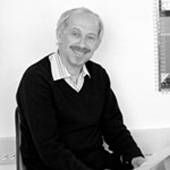 In 1986, Constantin Boym founded Boym Partners Inc. in New York City. His studio’s designs, many of which are produced in partnership with his wife, Laurene, include tableware for Alessi and Authentics, watches for Swatch, lighting for Flos, showrooms and retail displays for Vitra and exhibition installations for many American museums.
In 1986, Constantin Boym founded Boym Partners Inc. in New York City. His studio’s designs, many of which are produced in partnership with his wife, Laurene, include tableware for Alessi and Authentics, watches for Swatch, lighting for Flos, showrooms and retail displays for Vitra and exhibition installations for many American museums.